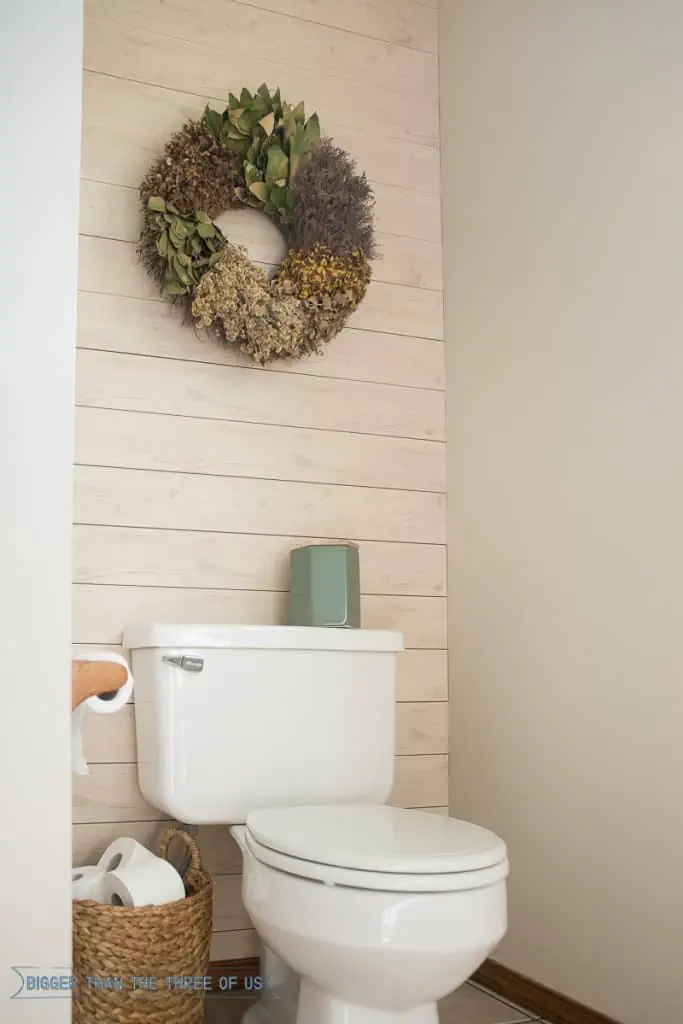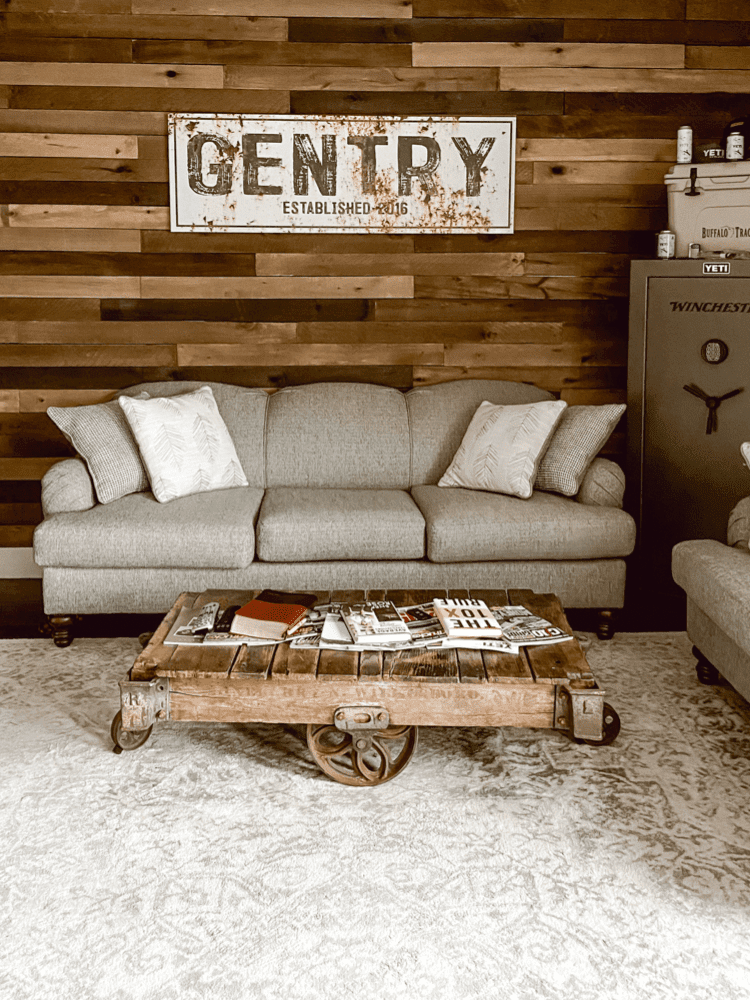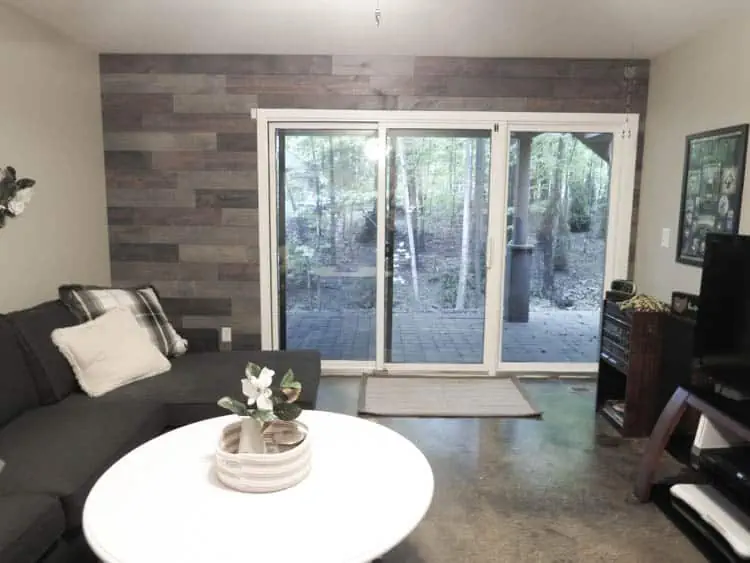Everything you need to know to choose the perfect wood for wood accent walls of all kinds including pros, cons, and lots of gorgeous examples.
One of my favorite ways to add color and texture to a boring room is with a wood accent wall.
In fact, I love a wood wall so much I’ve installed three in my home: a weathered wood plank wall, a herringbone wood wall, and a geometric wood wall.
When you’re creating a wood accent wall, one of the biggest decisions is figuring out what type of wood to use. This is the one factor that effects everything else including how much money your wall will cost, how easy it will be to install, and how it will look when it’s finished.
I’m sharing 9 different types of wood that make amazing wood accent walls along with the pros and cons of each and examples of the gorgeous walls you can create with them.
This post contains affiliate links which means if you make a purchase after clicking a link I will earn a small commission but it won’t cost you a penny more. Click here to see my full disclosure policy.

How to choose the best wood for a wood accent wall
When choosing the right wood for an accent wall, there is not one type of wood that is automatically best for every situation. Which type of wood will work best for you depends on several factors.
- Cost – A wood wall typically requires quite a bit of wood and wood comes in a huge range of price points from the super cheap to the high dollar. When choosing your wood, be sure to keep your budget in mind.
- Weight – Lightweight wood tends to work better for wood walls and is easier to install.
- Thickness – In general, the thinner the wood, the better. Thinner wood won’t protrude into the room as much and is also generally lighter. You can get wood as thin as 1/4″ thick which is ideal for walls; 1″ thick is probably the max you should consider for a wood wall.
- Ease of installation – Different types of wood can be attached in different ways. Wood can be glued to the wall, nailed to the wall, or a combination of both. Consider how comfortable you are with things like using a nail gun or cutting wood to size when you choose the wood for your wall.
- Wood finish – You can choose either unfinished wood or prefinished wood for your wood wall. Prefinished wood planks come in a variety of colors and finishes. Unfinished wood can be painted or stained to achieve the look you want, but keep in mind some less expensive plywoods may not take stain well.
Types of wood for wood accent walls
These are some of the best types of wood to use for wood accent walls. I’m sharing the pros and cons of each type of wood along with some gorgeous wood accent wall inspiration to help give you an idea of what you can do with it.
Prefinished wall planks
In recent years, quite a few companies have started selling wood planks specifically created for wood plank walls. These planks are typically lightweight, prefinished, and easy to install. If you want the easiest possible wood accent wall, this might be a good way to go.
Pros:
- Prefinished wall planks are specifically designed to work well for wood walls. They are thin and super lightweight. They also tend to be very easy to install. And unlike regular plywood or wood planks, these specialty wall planks come with step-by-step instructions detailing how to install them properly.
- These wall planks come in a variety of beautiful finishes that are all ready to install on the wall; no paint or stain needed. There are tons of color options, so you are sure to find what you are looking for whether you want a weathered vintage finish, traditional stained wood, or a clean white paint finish.
Cons:
- Because these wall planks are prefinished and ready to install, they are more expensive than any of the other wood options on this list. Doing a large wall can add up quickly.
- Some prefinished wall planks may still need to be sealed when used in a damp environment like a bathroom, so be sure to read the instructions carefully.
Examples:

Rustix Wood Wall Boards from Repurpose and Upcycle – Rustix wood wall boards

How to Install Accent Planks from Bigger Than The Three of Us – Inteplast wall planks

Shiplap Wall with Lumber Hardwood from Mornings on Macedonia – Weaber Lumber Hardwood Boards
A few of my favorite prefinished wall plank options:
Just click the pics below for more details about each type of wood wall plank.
Plywood cut into strips
Basic plywood is one of my favorite materials to use for wood walls. When cut into strips, plywood can be used to mimic the look of shiplap, create a herringbone wall, or create a modern geometric wall.
Pros:
- Plywood is great for walls because it is thin and lightweight which means you can easily hang it on the wall using only nails and it isn’t going to intrude too far into the room.
- Plywood comes in a range of qualities and prices from super cheap underlayment to more expensive stain-grade birch plywood. The cheaper plywoods are cheaper per square foot than any other available wood.
- Plywood can be ripped down to any size and shape you want. When cutting wood planks, you can choose any width that looks good for your project instead of being limited to stock sizes.
Cons:
- The cheaper plywoods that save you a lot of money are also pretty low quality. They work fine if you are planning to paint your wood anyway, but won’t work for stain.
- While it’s great that you can cut plywood into any size planks, ripping all the wood down to size does take a lot of time.
Examples:

DIY Wood Accent Wall on a Budget from Lovely Etc. – underlayment plywood

Weathered Wood Plank Wall from Lovely Etc. – 1/4″ plywood

DIY Shiplap Plank Wall from Making Joy and Pretty Things – underlayment plywood

DIY Wood Slat Wall from Making Manzanita – plywood cut into 1.5″ strips
Plywood cut into other shapes
Plywood can also be cut into all kinds of other shapes beyond the basic wood plank. In fact, the sky is really the limit.
Pros:
- As stated above, plywood is thin and lightweight and it is incredibly budget-friendly.
- Plywood can be cut into pretty much any shape you can think up from basic wood tiles to curved designs and complicated geometric shapes. Any wood wall idea you can dream up can be completed using plywood.
Cons:
- Custom cutting plywood into tiles and other unique shapes is going to take a lot of time.
- The cheapest plywoods aren’t always suitable for every type of wood wall. They may splinter and split more often during cutting and they often need to be painted rather than stained.
Examples:

DIY Shingle Accent Wall from Pine and Poplar – 1/4″ plywood

Plywood Accent Wall from Reality Daydream – 1/4″ plywood

Wood Tile Accent Wall from Houseful of Handmade – 1/4″ plywood cut into tiles
MDF
MDF stands for medium density fiberboard. MDF is a super smooth engineered wood product that is often used for simple DIY projects including wood walls. Working with MDF is very similar to working with real wood and it can be cut into any size planks or other shapes just like plywood.
Pros:
- MDF is super smooth which makes it exceptionally easy to cut. Unlike real wood, there are no knots, wood grain, or warping to work around. This also means your finished wall will have an extra smooth finish.
- MDF is generally cheaper than real wood, particularly similar wood that is straight and smooth.
Cons:
- MDF is really heavy compared to wood. That makes it harder to handle and work with. It also means it will be heavier on the wall and extra care needs to be taken when attaching it.
- MDF isn’t a great material to use around water. So if your wood wall is going to be in a bathroom or kitchen, MDF probably isn’t the best choice.
- While real wood can be as thin as 1/4″, MDF typically comes in thicknesses between 1/2″ and 1″ so it isn’t quite as thin.
Examples:

Board and Batten Wall under $50 from 2 the Sunnyside – sheet of MDF cut into strips
Shiplap
Shiplap boards are long wood planks with a groove cut into each of the long sides; these grooves help the boards lock into one another. We often think of crisp white horizontal planks when we think of shiplap, but shiplap can actually be hung horizontally or vertically and can be finished in a variety of colors and finishes.
Pros:
- The interlocking grooves called rabbet joints keep the spacing between boards uniform and speed up installation.
- Shiplap boards come in a range of finishes including both unfinished and prefinished options. You can achieve a wide range of looks and styles using shiplap in different finishes.
Cons:
- Shiplap is more expensive than most other types of wood because there is more work involved in milling it.
Examples:

Installing Shiplap in Bathroom from Sustain My Craft Habit – primed fiberboard shiplap

Pine Shiplap Boards from Two Hands DIY – pine shiplap
Wood planks
You can also create a wood accent wall using basic wood planks, also referred to as dimensional lumber or common board. Pine planks are most commonly used simply because they are the cheapest and most readily available. Wood planks come in a variety of sizes so you can create a variety of looks.
Pros:
- You can find wood planks in sizes ranging from 1″x2″ all the way up to 2″x12″. This makes it easy to find the perfect size for your project or even mix and match a variety of sizes. It’s best to stick to boards that are 1″ thick or less when working on a wood accent wall.
- Wood planks come unfinished and can be finished using any stain or paint you want.
- Because wood planks are a bit thicker than other woods like plywood, they are ideal if you are wanting to add more dimension to your wood wall.
Cons:
- Wood planks tend to be thicker and heavier than many other types of wood. Before using wood planks on a wall, be sure to think through how you will attach the weight securely to the wall.
- Wood planks come in a wide range of qualities from super rough cut furring strips to really nice hardwoods. This means you have lots of choices which is awesome, but it also means you are going to pay a lot for higher quality woods.
Examples:

Reclaimed Wood Wall from At Lane and High – 1×6 boards

How to Make a Feature Wall from Plywood from Pine and Poplar – plywood and 1×2 boards
Wood Lattice or Wood Lath
These thin strips of wood are sometimes referred to as wood lattice and sometimes as wood lath. Either way, they come in long, thin strips that are typically 1/4″ thick and 1.5″ wide.
Pros:
- Lath and lattice are very thin and lightweight making it ideal for wood strip walls. It is particularly good for creating board and batten walls; because it is so thin, it can be easily used without needing to change the existing baseboards.
- Lath and lattice are fairly inexpensive compared to many other woods. You could save money by cutting 1/4″ plywood into strips instead, but it would be a ton of work to cut such thin strips.
Cons:
- Lattice often comes pressure treated. Pressure treated wood is injected with chemicals to help protect it from rot and insects. This is great for outdoor projects, but not ideal for indoor projects. If possible, look for lath that is not pressure treated.
- Lath and lattice are often a rougher wood cut with more imperfections and are prone to warping because they are so thin.
Examples:

DIY Batten Wall Using Lattice Strips from Blesser House – wood lattice

Board and Batten Wainscoting Lattice from Abbotts at Home – wood lattice
Reclaimed wood
Reclaimed wood sounds fancy, but it really just means any wood that was originally used for a different purpose. Reclaimed wood may be wood pulled from pallets, wood from an old fence, or wood from someone’s scrap pile.
Pros:
- You can often find reclaimed wood for super cheap and sometimes it is even free. I have found some pretty amazing reclaimed wood on Craigslist, on Facebook marketplace, at estate sales, on the side of the road, and even in my own scrap wood pile.
- Reclaimed wood comes in all kinds of unique finishes including many weathered, rustic finishes that people spend a lot of time and money trying to mimic. You can find reclaimed wood in just about any finish and style you could want.
Cons:
- Reclaimed wood is usually far from perfect. It is often old and weathered which means it tends to be warped, bent, and full of old nails.
- Reclaimed wood is often thick and quite heavy, making it more difficult to work with and more difficult to hang on the wall.
- It also doesn’t tend to come in standardized sizes. No two pieces of reclaimed wood are alike, even if they came from the same source. They tend to have all different thicknesses and finishes. This can be part of the beauty of reclaimed wood, but it can also make it difficult to find enough pieces that look good together to complete an entire wall.
Examples:

Herringbone Plank Wall from Kaleidoscope Living – old cedar fence boards

Technically, this is a huge reclaimed wood barn door, not a wood wall, but the materials and process I used to make this door would work equally well on an accent wall.
Other woods
There are also other types of wood products you can use if you want to create a really unique, one-of-a-kind wood wall. I’ve seen wood accent walls created using cedar shakes, wood shims, and wood flooring.
I won’t list all the pros and cons of these since every one is different. Just keep in mind this is a great way to create a truly unique accent wall, but the nontraditional materials may be more difficult to work with than you anticipate.
Example:

Cedar Shake Shingles Accent Wall from A Life Unfolding – cedar shake shingles
Hopefully now you feel like you have the information you need to choose the perfect wood for your next wood wall. (And if your head is spinning and you’re looking for the easy button, I’d say you can’t go wrong with good old 1/4″ plywood!)
More DIY home ideas I think you’ll like:
I’d love for you to pin this post on Pinterest!



Michelle says
Fantastic article, so much useful information and beautiful ideas. Thanks for including us. Have a great day.
Carrie says
Thanks for letting me include you guys – your wall is beautiful!